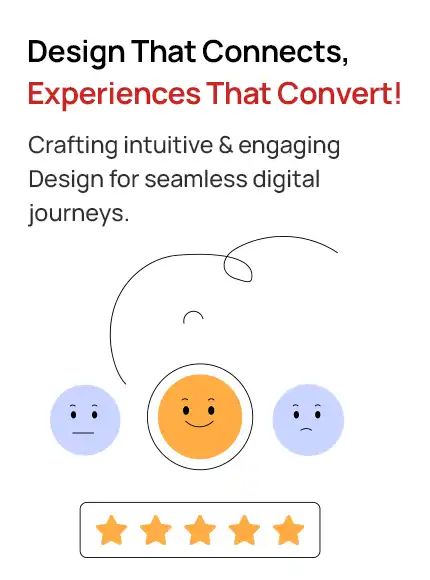
Branding for Financial Services: How to Build Trust, Stand Out, and Grow Your Business
June 9, 2025
How Custom Website Design Boosts Revenue for Your Business
June 16, 2025
Branding for Financial Services: How to Build Trust, Stand Out, and Grow Your Business
June 9, 2025
How Custom Website Design Boosts Revenue for Your Business
June 16, 2025Why Strong Brand Identity Is Key to Business Success
June 13, 2025
- 18 min to Read
Introduction
Every business wants to stand out. Whether you're launching a startup or growing an established company, how people perceive your brand can make or break your success.
In a marketplace full of noise, flashy ads, and competitive offerings, brand identity acts as your silent salesperson—working 24/7 to communicate who you are, what you stand for, and why people should care.
So, what exactly is brand identity? What makes brand identity such a powerful driver of business growth?
Let's dive deep into how building a strong brand identity helps cultivate trust, recognition, and long-term loyalty—the trifecta of any thriving business.
Unlock the Secret to Business Growth
Find out how a strong brand identity fuels customer loyalty and market dominance.
What Is Brand Identity?
Brand identity is the visible and emotional expression of your business. It includes everything from your logo, color palette, and typography to your messaging, tone of voice, customer experience, and even the emotions your brand evokes.
Imagine your business as a person. How do they dress? How do they talk? What values do they hold? That personality—consistent, relatable, and memorable—is what forms your brand identity.
It’s not just about how you look, but how you make people feel. And those feelings drive decisions, actions, and loyalty.
The Business Case for Strong Brand Identity
1. Instant Recognition
Consumers are overwhelmed by choices. A clear and consistent identity helps your business get noticed and remembered. Think of how easily you recognize brands like Coca-Cola, Apple, or Spotify. Their colors, logos, and tone are so consistent that even without their names, you know exactly who they are.
This kind of instant recognition builds mental availability—a key marketing concept that makes your brand top-of-mind when customers are ready to buy.
2. Trust and Credibility
Trust is the currency of modern business. A polished and professional brand identity sends a signal that you are reliable, experienced, and invested in quality. On the flip side, inconsistent or outdated branding can make even the best products feel sketchy.
People buy from brands they trust. And that trust starts with the first impression your identity creates.
3. Emotional Connection
Brands that resonate on a human level drive stronger engagement. A well-crafted identity communicates values, personality, and purpose. These emotional cues help your audience feel like your brand "gets" them.
Emotional branding is why people tattoo Nike swooshes or wait in line for new Apple releases. They're not just buying products; they’re joining a lifestyle.
4. Competitive Edge
In saturated markets, features and pricing often blur together. What sets you apart is your story and how you tell it. Brand identity gives you a unique voice in a crowded room.
Customers aren’t just choosing between products; they’re choosing between brands. A unique identity gives them a reason to pick you.
5. Internal Alignment
Your team is your first audience. A clear identity helps everyone understand and align with your brand’s mission, values, and voice. It boosts morale, sharpens focus, and creates consistency in how your brand is represented inside and out.
Elements That Make Up a Strong Brand Identity
Let’s explore the core elements that shape a brand identity people remember and trust.
1. Logo
This is your brand's handshake. It should be simple, scalable, and instantly recognizable. Avoid trends and focus on timeless design.
2. Color Palette
Colors evoke emotion. Choose a palette that reflects your brand personality and use it consistently. For example, blue often conveys trust and professionalism, while red can evoke energy and passion.
3. Typography
Your fonts speak volumes. Your typography should speak your brand’s language—be it contemporary, timeless, lighthearted, or professional. Keep it consistent across all platforms.
4. Imagery and Visual Style
From photography to illustrations, your visual content should align with your brand vibe. Is it minimal and clean, or bold and dynamic?
5. Voice and Tone
How does your brand speak? Your messaging should have a consistent tone that aligns with your audience—whether it's friendly and casual or formal and authoritative.
6. Values and Mission Statement
What does your brand stand for? What’s your purpose beyond profit? Your values help attract like-minded customers and build loyalty.
7. Customer Experience
Your brand identity extends to how you treat customers, respond to feedback, and deliver your products or services. Every touchpoint counts.
Real-World Examples of Powerful Brand Identity
Apple
Minimal, elegant, innovative. Apple’s identity is reflected in every detail—from their clean design and packaging to their aspirational messaging. The result? A brand that inspires loyalty and a sense of belonging.
Nike
Empowerment, performance, and resilience. Nike’s bold typography, action-packed visuals, and iconic slogan ("Just Do It") make it one of the most emotionally resonant brands in the world.
Airbnb
Their identity is all about belonging and community. From warm imagery to inclusive language, Airbnb’s branding creates a feeling of home, no matter where you go.
How Brand Identity Drives Long-Term Success
1. Improved Marketing ROI
With a clear brand identity, your marketing efforts become more effective. Ads, content, and campaigns don't just attract attention—they build a cohesive narrative that sticks with your audience.
2. Customer Loyalty and Advocacy
People return to brands they trust and resonate with. They also recommend them to others. A strong identity builds relationships that go beyond transactions.
3. Increased Perceived Value
A strong identity can position your brand as premium, even if your pricing isn’t. Perception matters. Design and messaging can elevate how your products or services are seen.
4. Business Scalability
As you grow, a well-defined identity provides the consistency needed to scale. Whether you're opening new locations or expanding globally, your brand remains recognizable and relatable.
Common Mistakes to Avoid
- Inconsistency Using different styles, tones, or logos across platforms confuses customers and weakens brand equity.
- Copying Competitors Inspiration is fine. But your identity should reflect your story, not someone else’s.
- Forgetting Your Audience Build for them, not you. Our brand’s voice should speak to your audience, not echo only within your company walls.
- Overcomplicating Things Keep it simple. Strong identities are often minimal and clear. Less is more.
When to Revisit Your Brand Identity
Your brand identity isn’t set in stone. Here’s when you might consider a refresh:- You’re targeting a new audience
- Your offerings have changed
- Your branding looks outdated
- Your messaging feels unclear
- You’re merging or expanding markets
Building a Strong Brand Identity from Scratch
Here’s a step-by-step roadmap for building a powerful identity, whether you're launching or rebranding:
1. Know Your Audience
You can't build a meaningful brand without knowing who you're speaking to. Dig into the mindset of your ideal customers—what excites them, what problems they face, and what influences their decisions. Go beyond surface demographics and uncover emotional triggers. When your brand feels like it was built just for them, connection happens naturally—and that’s when loyalty starts to form.
2. Define Your Brand Strategy
This is the heartbeat of your brand. What do you stand for? Why should people care? Define a mission that inspires, values that guide you, and a brand promise that people can believe in. Your strategy sets the tone for every decision—from how you talk to how you grow. Without a clear strategy, you're not building a brand—you’re just creating noise.
3. Design Your Visual Elements
First impressions matter—and visuals speak louder than words. Create a logo that stands out, choose colors that evoke feeling, and use fonts that reflect your brand’s personality. Every design element should tell a story about who you are. Whether bold and modern or soft and minimalist, your visual identity should be memorable, recognizable, and rooted in authenticity.
4. Develop Brand Guidelines
Think of brand guidelines as your visual and verbal playbook. They ensure that no matter who’s creating content—your team, a freelancer, or a partner—your brand looks and sounds consistent. From logo usage and color codes to tone of voice and image styling, this rulebook keeps your identity aligned, sharp, and unmistakably yours across every channel.
5. Apply Across All Channels
Now it’s time to show up—everywhere. Your brand identity should be woven into every customer touchpoint: your website, social feeds, product packaging, emails, and even the way your team answers the phone. When your brand shows up consistently, it becomes familiar. And familiarity breeds trust—the kind of trust that turns first-time buyers into lifelong Fans.
Why Brand Guidelines Are Essential for a Consistent Identity
Building a strong brand identity is just the beginning. To keep that identity clear and trustworthy, you need well-defined brand guidelines. Think of these guidelines as the rulebook that tells everyone—whether it’s your team, designers, or marketing partners—how to represent your brand properly.
These guidelines cover the essentials: how your logo should appear, which colors to use, the fonts that match your style, and even the tone of voice your brand speaks in. This ensures that every piece of content or communication feels like it’s coming from the same place—authentic and unmistakably you. Without this consistency, your brand risks looking scattered or confusing, which can erode the trust and recognition you’ve worked hard to build. Regularly updating your brand guidelines helps keep your identity fresh, aligned with your evolving business, and always memorable.Investing in Professional Help
Sometimes, you need more than a DIY approach. Collaborating with experts in branding and identity design services can help bring clarity, creativity, and strategic focus to your branding efforts. Their experience ensures that your brand isn’t just attractive but also strategically positioned to grow.
For businesses aiming to elevate their presence, professional brand identity design services can be the turning point between being average and becoming unforgettable.
Conclusion
Your brand identity is more than just a look—it’s the lasting impression that shapes how people remember you. It’s your story, your promise, and the bridge that connects your business to the hearts of those you serve.
In a world where attention spans are fleeting and loyalty is earned, a powerful brand identity isn’t optional—it’s essential.
At Upclues, we understand that building a brand isn’t just about aesthetics—it’s about creating an authentic experience that resonates deeply and stands the test of time. Whether you’re launching fresh or refreshing your presence, investing in a clear, consistent, and genuine identity is the smartest move to unlock lasting growth and success.
Unlock the Secret to Business Growth
Find out how a strong brand identity fuels customer loyalty and market dominance.





